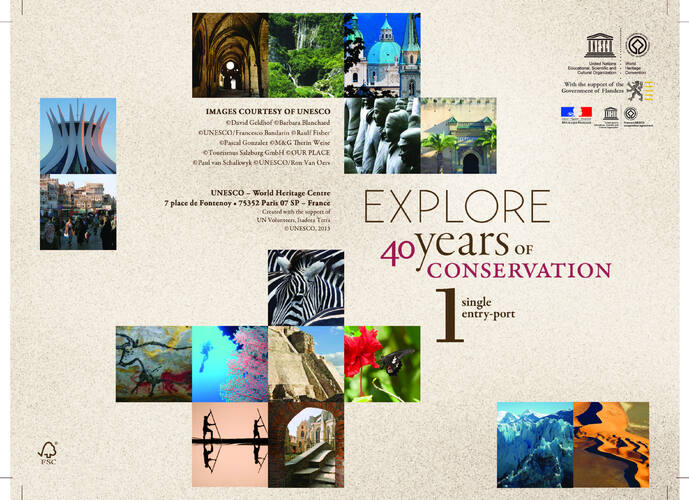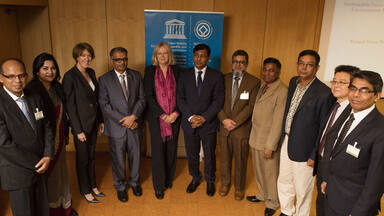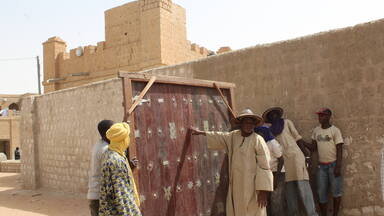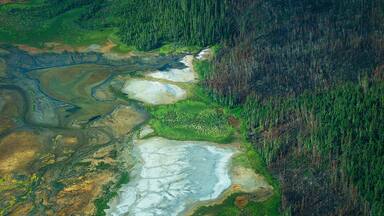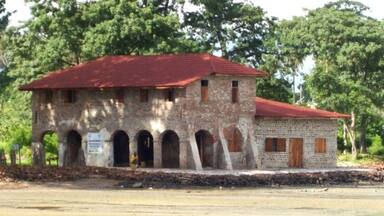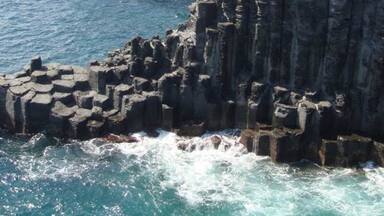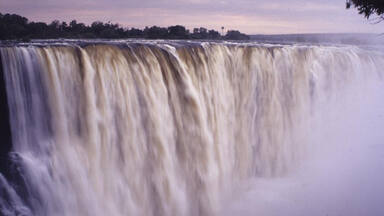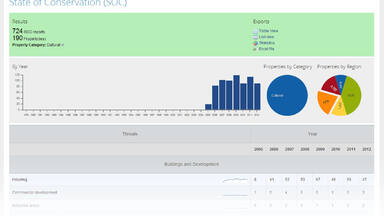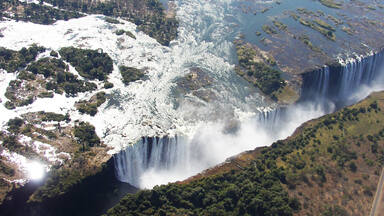State of conservation Information System
Conservation, at the core of the World Heritage Convention
Article 4 of the World Heritage Convention refers to the conservation of properties inscribed on the World Heritage List and indicates that “each State Party to this Convention recognizes that the duty of ensuring the identification, protection, conservation, presentation and transmission to future generations of the cultural and natural heritage (…) situated on its territory, (… and) will do all it can to this end (…)”.
Furthermore, Paragraph 169 of the Operational Guidelines provides a detailed definition of the reactive monitoring process (“SOC process”) as being the “reporting by the Secretariat (…) and the Advisory Bodies to the Committee on the state of conservation of specific World Heritage properties that are under threat (…)”. These reports on the state of conservation of selected properties are examined each year by the World Heritage Committee. Since1979, over 3.000 state of conservation reports (“SOC reports”) were prepared and represent an exceptional documentation on conservation issues; one of the most comprehensive monitoring systems of any international conventions.
A need to identify trends
At its 32nd session (Quebec City, 2008), the World Heritage Committee requested the World Heritage Centre to prepare an analytical summary of the state of conservation of the properties discussed at the 32nd session, identifying perceived trends (Decision 32 COM 7B.129).
The following year, at its 33rd session (Seville, 2009), after having taken note of this analytical summary the World Heritage Committee requested the World Heritage Centre to prepare an analytical summary of the perceived trends, changes and threats to properties, based on an analysis of the state of conservation of World Heritage properties over five years (2005-2009) (Decision 33 COM 7C). This document (WHC-10/34.COM/7C), examined by the World Heritage Committee at its 34th session (Brasilia, 2010), was welcomed, as the basis for further reflection and more extensive analysis of this information. The Committee also considered that this work highlighted the need for more systematic monitoring of threats and of how to identify and react to emerging trends.
Subsequently, the Committee welcomed the offer made by the Governments of Australia and Senegal to organize an expert meeting on strategies to address global state of conservation challenges (Decision 34 COM 10D) (Dakar, Senegal, 13-15 April 2011, see page https://whc.unesco.org/en/events/740/). The main objectives of this expert meeting were to identify trends/themes in state of conservation reporting, to facilitate information sharing on management approaches to common problems, to consider what guidance was available to assist States Parties prevent and mitigate threats, and to discuss issues to include in policy approaches to common threats. The meeting aimed at proposing improvements to the processes and procedures used to monitor the state of conservation of World Heritage properties.
At its 35th session (UNESCO, 2011), after having endorsed the recommendations of the Dakar expert meeting (Decision 35 COM 7C), the World Heritage Committee pursued its on-going reflection on the trends of the state of conservation of properties and, considering “the need for more systematic monitoring of threats”, called upon the States Parties to the Convention to support the proposed establishment of a comprehensive "State of conservation Information System" to support analytical studies and assist all stakeholders in site-management, with the target to make this system operational, on the World Heritage Centre's website, by the 37th session of the World Heritage Committee in 2013.
The completion of the Information System project
In response to Decision 35 COM 7C, the World Heritage Centre designed a project aiming at developing such Information System for all stakeholders of the Convention and presented it to various potential donors. The Flemish Government responded positively to support this ambitious project.
The main objective of the project consisted in the development of a comprehensive and integrated computerized information system (database) on the state of conservation of the World Heritage properties examined by the World Heritage Committee since 1979, and on the factors identified as negatively affecting their Outstanding Universal Value. In addition, this Information System should allow users to link the numerous documents related to the state of conservation of a specific property (SOC reports, reports by the State Party, mission reports, Committee decisions, etc.), which were archived in various formats and disseminated in various webpages.
After a 2-year development phase, the State of conservation Information System was completed at the end of September 2013, hosted on the World Heritage Centre’s website at https://whc.unesco.org/en/soc, and integrated with all other current databases (on Nominations, International Assistance, Tentative Lists, States Parties information, statutory documentation, World Heritage Committee’s decisions, etc.). This tool is publicly available for all stakeholders of the Convention.
The Information System comes with an advanced search function (per year, per property, per State Party, per Region, per type of threat, etc.) in order to extract the set of data required by the users and to provide the relevant statistics and charts.
In addition to its purpose in monitoring the state of conservation of properties, this Information System also highly contributes to the institutional memory of the World Heritage Convention and facilitates well-informed and consistent decision-making.
This tool also allows all users to conduct comprehensive analyses of the threats affecting the properties and their evolution over time. These analyses help identify generic threats, underlying key issues and potential trends over time. They also assist States Parties to improve the mitigation measures to better protect their properties.
Decisions / Resolutions (8)
The World Heritage Committee,
- Having examined Document WHC/21/44.COM/7,
- Recalling Decisions 40 COM 7, 41 COM 7, 42 COM 7 and 43 COM 7.1, adopted at its 40th (Istanbul/UNESCO, 2016), 41st (Krakow, 2017), 42nd (Manama, 2018) and 43rd (Baku, 2019) sessions respectively,
Evaluation of the Reactive Monitoring process
- Taking note with appreciation of the recommendations of the evaluation of the Reactive Monitoring process, as prioritized in line with Decision 43 COM 7.1, requests all stakeholders of the Convention to implement them at their level as soon as possible;
- Welcomes the matrix structure developed by the World Heritage Centre in consultation with the Advisory Bodies, which provides a clear framework to report back to the Committee on the implementation of the priority recommendations, and requests them to prepare an Implementation Plan;
- Also requests the World Heritage Centre, in consultation with the Advisory Bodies, and in line with Recommendation 34 of the evaluation, to present a progress report on the implementation of the recommendations, for examination at its 47th session;
Issues related to the List of World Heritage in Danger
- Reaffirming the need to promote a better understanding of the provisions of the World Heritage Convention and in particular of the implications and benefits of properties being inscribed on the List of World Heritage in Danger and the need to underline that removal of a World Heritage property from the List of World Heritage in Danger is a significant ‘success story’,
- Mindful of its Decision 43 COM 8C.3, which recalled that the inscription of a property on the List of World Heritage in Danger aims to marshal international support to help the State Party effectively address the challenges faced by the property by engaging with the World Heritage Centre and the Advisory Bodies to develop a program of corrective measures to achieve the desired state of conservation for the property, as provided for under Paragraph 183 of the Operational Guidelines; and noting that inscription on the List of World Heritage in Danger also alerts the State Party about the international community’s concern on the state of conservation of the property, provides a timely reminder of obligations that arise under the World Heritage Convention, highlights threats to the attributes of a property which contribute to its Outstanding Universal Value (OUV), and, importantly, initiates a process and pathway to address those threats, including the availability of additional funding,
- Also noting that the development of a Desired state of conservation for the removal of a property from the List of World Heritage in Danger (DSOCR) and a programme for corrective measures is a critical part of the procedure for managing and addressing threats to the OUV of properties inscribed on the List of World Heritage in Danger,
- Takes note with appreciation of the information contained in Document WHC/21/44.COM/7 (Part I.B.) and recognizes that the existing monitoring processes are leading over time to a significant improvement in the conservation status of properties inscribed on the List of World Heritage in Danger;
- Also recalling its previous request for States Parties to develop and submit DSOCRs for all properties included in the List of World Heritage in Danger by its 40th session in 2016 at the latest, expresses its concern however that less than half of the properties inscribed on the List of World Heritage in Danger have a DSOCR and therefore strongly urges all States Parties concerned to:
- Use the 2013 Guidance to develop and submit DSOCRs with quantifiable indicators to track progress for all remaining properties as soon as practicable, with a view to having them all in place by its46th session, with the support of the World Heritage Centre and Advisory Bodies;
- Ensure that for any property newly inscribed on the List of World Heritage in Danger, a DSOCR is developed and submitted no later than one year following inscription;
- Acknowledging initial pilot activities to explore possible approaches and methodologies for costed action plans, requests these efforts to continue and calls upon all interested States Parties to support a workshop to develop a common methodology and guidelines for when and how corrective measures might be supported by costed action plans;
- Also strongly urges States Parties, NGOs, private sector and donors to redouble efforts to prioritize attention to those World Heritage properties, which have been on the List of World Heritage in Danger for 10 years or longer;
- Thanks the State Party of Romania for having hosted a multi-stakeholders international workshop in September 2019, providing a unique space for discussions and networking of professionals regarding the preservation of cultural and natural World Heritage facing dangers, including exchange of good practice, and highlighting the benefits of the List of World Heritage in Danger;
- Expresses its gratitude to the State Party of Norway for its generous support for a project that aims to improve the perception of the List of World Heritage in Danger, and also requests the World Heritage Centre to present a progress report on this activity to its 45th session.
The World Heritage Committee,
- Having examined Documents WHC/19/43.COM/7,
- Recalling Decisions 40 COM 7, 41 COM 7, and 42 COM 7, adopted at its 40th (Istanbul/UNESCO, 2016), 41st (Krakow, 2017) and 42nd (Manama, 2018) sessions respectively,
- Thanks the State Party of Azerbaijan, Host Country of the 43rd session of the World Heritage Committee (Baku, 2019), for having organized the third World Heritage Site Managers’ Forum, as a capacity-building exercise aimed at increasing the understanding of the World Heritage decision-making process among site managers, in order to achieve more effective protection of Outstanding Universal Value (OUV), takes note with appreciation of the 2019 World Heritage Site Managers’ Forum Statement and encourages the future Host Countries to continue this initiative in conjunction with the World Heritage Committee session;
Evaluation of the Reactive Monitoring process - Taking note with appreciation of the evaluation of the Reactive Monitoring process launched by the World Heritage Centre, thanks the State Party of Switzerland for its financial support, as well as the experts tasked with this evaluation, for their thorough analysis of this process, instrumental in achieving the objectives of the World Heritage Convention;
- Expresses its gratitude to all the stakeholders of the Convention who have actively contributed to this evaluation;
- Notes that the recommendations formulated in the evaluation refer to improvements of the current practices and do not call for structural changes nor amendments to the statutory documents, and requests all stakeholders of the Convention to take them on-board and implement them at their level as soon as possible;
- Agrees that the World Heritage Centre should prioritize implementation of the high priority recommendations, with an initial focus on those relevant to communication, capacity-building, including for site managers, and finance;
- Also requests the World Heritage Centre to present a progress report on the implementation of the recommendations, for examination by the World Heritage Committee at its 44th session in 2020;
Issues related to the List of World Heritage in Danger - Reaffirming the need to promote a better understanding of the implications and benefits of properties being inscribed on the List of World Heritage in Danger,
- Thanks the State Party of Romania for its initiative to host a multi-stakeholder international workshop focusing on the List of World Heritage in Danger, including exchange of good practice, promotion of the properties inscribed on this List and the conservation needs to improve their state of conservation, such as Costed Action Plans;
- Requests the World Heritage Centre to present a report on this workshop and other initiatives related to the List of World Heritage in Danger at the 44th session in 2020;
Selection of the World Heritage properties to be proposed for discussion - Reaffirming the importance of focusing the debates on those properties and global conservation issues of greatest concern during the World Heritage Committee sessions, and taking into account the results of the evaluation of the Reactive Monitoring process,
- Supports the outcomes of the reflection conducted by the World Heritage Centre and the Advisory Bodies regarding the elaboration of the list of state of conservation reports to be proposed for discussion by the Committee, as well as the current practice allowing Committee members to add to this list the reports they wish to discuss, by providing a written request to the Chairperson of the Committee, through the World Heritage Centre, sufficiently in advance of the session, and indicating the reason why the reports are requested to be opened for discussion;
- Recognizes that the selection of the state of conservation reports to be discussed by the Committee during its sessions should be based on clear and objective criteria, including the level of threat to the property, rather than being based on representativity.
The World Heritage Committee,
- Having examined Documents WHC/19/43.COM/7, WHC/19/43.COM/7A, WHC/19/43.COM/7A.Add, WHC/19/43.COM/7A.Add.2, WHC/19/43.COM/7A.Add.3, WHC/19/43.COM/7B, WHC/19/43.COM/7B.Add, WHC/19/43.COM/7B.Add.2 and WHC/19/43.COM/7A.Add.3,
- Recalling Decisions 40 COM 7, 41 COM 7, and 42 COM 7, adopted at its 40th (Istanbul/UNESCO, 2016), 41st (Krakow, 2017) and 42nd (Manama, 2018) sessions respectively,
Emergency situations resulting from conflicts - Deplores the loss of human life as well as the degradation of humanitarian conditions resulting from the prevailing conflict situations in several countries, and expresses its utmost concern at the devastating damage sustained and the continuing threats facing cultural and natural heritage in general;
- Expresses its deep concern at the inter-community conflicts observed in Mali between the Dogon and Fulani communities, which have caused considerable loss of human life and significant damage to the cultural heritage, particularly within the World Heritage property of the Cliffs of Bandiagara (Land of the Dogons);
- Thanks the State Party of Mali for the urgent actions that have been put in place to ensure the safety of communities in and around the property, and encourages the State Party, to also take into account in its actions the protection of the property’s rich cultural heritage, and to do so in collaboration with the stakeholders involved in the establishment of long-term peace in Mali;
- Welcomes the dispatch of a UNESCO mission to assess the damage caused to the property, and identify the needs related to the built and intangible cultural heritage and the objects and practices associated with the Cliffs of Bandiagara, in order to propose an Action Plan for the rehabilitation of the villages concerned;
- Urges again all parties associated with conflicts to refrain from any action that would cause further damage to cultural and natural heritage and to fulfill their obligations under international law by taking all possible measures to protect such heritage, in particular the safeguarding of World Heritage properties and the sites included in the Tentative List;
- Also urges again States Parties to adopt measures against using World Heritage properties for military purposes and to stop related uncontrolled development and impact;
- Reiterates its utmost concern about the continuing threats of wildlife poaching and illegal trafficking of wildlife products linked to impacts of conflict and organized crime, which is eroding the biodiversity and Outstanding Universal Value (OUV) of many World Heritage sites across the world, and urges States Parties to take the necessary measures to curb this problem, including through the implementation of the Convention on International Trade in Endangered Species of Wild Fauna and Flora (CITES);
- Calls upon the international community to further support the safeguarding of the cultural and natural heritage of countries affected by conflict, through earmarked funds or through contributions to the UNESCO Heritage Emergency Fund;
- Appeals to all Member States of UNESCO to cooperate in the fight against the illicit trafficking of cultural objects, as well as cultural heritage protection in general, including through the implementation of United Nations Security Council Resolutions 2199 (2015), 2253 (2015) and 2347 (2017);
Reconstruction - Thanks the State Party of Poland for the efforts to widely disseminate the Warsaw Recommendation on Recovery and Reconstruction of Cultural Heritage, as well as the proceedings of the international conference "The Challenges of World Heritage Recovery" held in Warsaw in May 2018;
- Welcomes the policy document "Culture in the reconstruction and rehabilitation of cities", published by UNESCO and the World Bank, which contributes to the reflection launched on the challenges related to the reconstruction of World Heritage properties;
- Requests the World Heritage Centre, ICOMOS and ICCROM and the States Parties to the World Heritage Convention, to continue the reflection on the recovery and reconstruction of World Heritage properties, and requests the World Heritage Centre and the Advisory Bodies report back to the World Heritage Committee on the progress made in improving advice in this regard;
Climate Change - Notes with appreciation the initiatives taken by the World Heritage Centre and the Advisory Bodies to advance work on updating the Policy Document on the Impacts of Climate Change on World Heritage properties, including through a planned widespread online consultation with States Parties, Advisory Bodies and civil society;
- Requests that the development of the updated Policy Document be completed for consideration by the Committee at its 44th session in 2020;
- Welcomes the initiative taken by the World Heritage Centre together with a global private-public consortium of partners, to build climate adaptation strategies across five marine World Heritage sites in Australia, Belize, France and Palau;
- Urges all States Parties to step up action toward better understanding the climate vulnerability of World Heritage properties and put in place adaptation strategies that strengthen the resilience of properties and ensure the conservation of their Outstanding Universal Value.
The World Heritage Committee,
- Having examined Documents WHC/19/43.COM/7, WHC/19/43.COM/7A, WHC/19/43.COM/7A.Add, WHC/19/43.COM/7A.Add.2, WHC/19/43.COM/7A.Add.3, WHC/19/43.COM/7B, WHC/19/43.COM/7B.Add, WHC/19/43.COM/7B.Add.2 and WHC/19/43.COM/7A.Add.3,
- Recalling Decision 42 COM 7, adopted at its 42nd (Manama, 2018),
Management Plans in the context of urban development - Noting that the many Management Plans and management systems for urban properties are not adequately anchored in the legal mechanisms, systems, and processes for urban development,
- Also noting that the pressures of high investment urban development projects in and around properties are increasingly a threat to their Outstanding Universal Value (OUV), and that in contrast, the OUV could provide a valuable opportunity for the property and its wider setting to define a new urban vision that integrates and valorizes the OUV with new needs and aspirations,
- Recalling that the approach of the 2011 UNESCO Recommendation on the Historic Urban Landscape has highlighted the need for urban areas to be well integrated into their wider social, economic and cultural context, calls on all States Parties to prepare and deliver Management Plans, for properties in and around urban areas, so that their planning elements can be integrated directly into the planning and development policies, plans, processes and instruments; regardless of whether the property is inscribed for its urban values or not;
- Requests the World Heritage Centre and the Advisory Bodies to continue reflecting on the mechanisms and tools needed to assess and guide interventions in and around urban properties to sustain the OUV of the properties and to promote sustainable development and actively engage with the wider development processes that could over time impact the appearance, use, and meaning of buildings and spaces in properties and their settings;
- Notes with appreciation the International Union of Architects Forum (UIA) on “Mass Tourism in Historic Cities”, which was held in Baku, Azerbaijan, on 7-9 June 2019 and welcomes the proposal of the UIA to prepare, in close cooperation with the World Heritage Centre and the Advisory Bodies, guidelines for architectural competitions in and around World Heritage urban properties that will recognise their Outstanding Universal Value;
- Welcomes the offer of the Government of Japan to host an international experts meeting in January 2020 to provide further guidelines for the integration of the assessment of the impacts for interventions in the wider processes of urban management by applying the 2011 Recommendation on the Historic Urban Landscape to address the challenges of increased urbanization in close cooperation with the World Heritage Centre and the Advisory Bodies;
- Calls on the UNESCO Secretariat to develop measures to address the inherently limited nature of institutional capacity in SIDS, acting as an impediment in identifying, inventorying and proposing potential cultural and natural heritage sites for listing;
Tourism - Acknowledging the contribution of sustainable tourism to the 2030 Agenda on Sustainable Development and the positive impact it can have on local communities and the protection of World Heritage properties, nevertheless notes with concern that the number of properties negatively affected by overcrowding, congestion and tourism infrastructure development continues to increase;
- Noting that the protection of Outstanding Universal Value (OUV) must be a central objective for all World Heritage properties, requests States Parties to develop visitor management plans and strategies that address the seasonality of tourism (smoothing visitor numbers over time and spreading visitors across sites), encourage longer more in-depth experiences promoting tourism products and services that reflect natural and cultural values, and limit access and activities to improve visitor flows and experiences, while reducing pressures on the attributes which underpin OUV ;
- Encourages the States Parties to support UNESCO in its efforts to assist heritage and tourism managers with system development and data collection to help destinations understand their specific situations and early warning signs, provide incentives for sustainable tourism development and raise awareness to change visitor behaviour;
- Calls on UNESCO Secretariat to recognize opportunities for forging synergies between core UNESCO activities that could be harnessed to strengthen heritage sites: youth, heritage tourism training, sustainable heritage tourism and biodiversity, and relate it directly to SIDS;
Heritage Impact Assessments / Environmental Impact Assessments (HIAs/EIAs) - Notes the progress of revising the guidance on impact assessment for World Heritage undertaken by the ICCROM/IUCN World Heritage Leadership Programme together with the World Heritage Centre and ICOMOS.
The World Heritage Committee,
1. Having examined Documents WHC-11/35.COM/7C, WHC-11/35.COM/INF.7C and WHC-11/35.COM/7B,
2. Recalling Decision 34 COM 7C, adopted at its 34th session (Brasilia, 2010),
3. Thanks the States Parties of Senegal and Australia for the organization of the Expert meeting on the global state of conservation challenges for World Heritage properties (Dakar, Senegal, 13-15 April 2011);
4. Endorses the recommendations of the Expert meeting on the global state of conservation challenges for World Heritage properties presented in Document WHC-11/35.COM/INF.7C and invites States Parties to the Convention, the World Heritage Centre and the Advisory Bodies to develop plans to implement them, and identify the required resources;
5. Considering the need for more systematic monitoring of threats, calls upon the States Parties to the Convention to support the establishment of a comprehensive "state of conservation information system" to support analytical studies and assist all stakeholders in site-management, with the target to make this system available, on the World Heritage Centre's website, before the 37th session of the World Heritage Committee in 2013;
6. Requests the World Heritage Centre, in consultation with the Advisory Bodies, to prepare clear modalities and guidance for the drafting and adoption of the Desired state of conservation for the removal of properties from the List of World Heritage in Danger, for examination by the World Heritage Committee at its 36th session in 2012;
7. Decides to amend paragraph 183 of the Operational Guidelines to read: "When considering the inscription of a property on the List of World Heritage in Danger, the Committee shall develop, and adopt, as far as possible, in consultation with the State Party concerned, a Desired state of conservation for the removal of the property from the List of World Heritage in Danger, and a programme for corrective measures";
8. Also requests the World Heritage Centre and Advisory Bodies to prepare a progress report on the issues mentioned above, for examination by the World Heritage Committee at its 36th session in 2012.
Read more about the decisionThe World Heritage Committee,
1. Having examined Document WHC-10/34.COM/10D,
2. Recalling Decision 33 COM 11C adopted at its 33rd session (Seville, 2009),
3. Notes the strong results obtained by the AFRICA 2009 programme from 1998 - 2009;
4. Notes with appreciation the work done by the 5 institutional partners, ICCROM, the UNESCO World Heritage Centre, CRATerre-ENSAG, EPA, and CHDA to contribute to the successful implementation of the programme;
5. Also notes with great appreciation the role of the financial partners, the Swedish International Development Cooperation Agency (Sida) through the Swedish National Heritage Board, the Ministries of Foreign Affairs of Norway, Italy and Finland, the UNESCO World Heritage Fund, and ICCROM in the success of the programme;
6. Endorses the concept of a new programme to be managed by the regional institutions to consolidate the gains of AFRICA 2009 and to expand its scope to include natural heritage conservation;
7. Requests the World Heritage Centre and Advisory Bodies to continue to support capacity building efforts in Africa and to ensure that the new programme's objective takes into account results of the second cycle of the periodic reporting exercise for Africa;
8. Welcomes the offer of the Governments of Australia and Senegal to organize an expert meeting in Dakar, Senegal in mid April 2011 on strategies to address global state of conservation challenges, with a focus on Africa, and also requests a report on the outcomes of the meeting at the 35th session of the World Heritage Committee in 2011;
9. Further requests State Parties to prioritize the allocation of additional financial resources to ensure the successful implementation of the new programme.
10. Requests furthermore the World Heritage Centre to report to the 35th session of the Committee in 2011 on the proposed framework and modalities for the new Africa 2020 programme.
Read more about the decisionThe World Heritage Committee,
1. Having examined Documents WHC-09/33.COM/7B and WHC-09/33.COM/7B.Add,
2. Recalling Decision 32 COM 7B.129, adopted at its 32nd session (Quebec City, 2008),
3. Takes note of the process being followed to consult State Parties to ensure the accuracy of the state of conservation reports during their preparation, as presented in the introduction of Document WHC-09/33.COM/7B and requests the World Heritage Centre to make every effort to ensure that States Parties' input is included in these reports before they are distributed;
4. Recognizes the efforts on the inclusion of references in the Working Documents on State of Conservation to the image gallery of the web-pages of the World Heritage Centre and encourages States Parties to provide the World Heritage Centre, whenever possible, with verified electronic illustrative material;
5. Considers that its request, in Decision 32 COM 7B.129, to add a link to illustrative material also aimed at providing background information on cases indicating the potential of visual impact on the Outstanding Universal Value of a property and to make visual impact simulations provided by States Parties available to Members of the Word Heritage Committee;
6. Encourages States Parties to provide electronic illustrations of proposed projects in their State of Conservation Reports and to make these available to the Members of the World Heritage Committee;
7. Acknowledging the increasing number of State of Conservation reports and that reviewing these is a key tool for ensuring the effective conservation and credibility of World Heritage properties,
8. Noting the results of the analytical document on trends provided with Circular Letter CL/WHC-09/03 and the in-depth discussion that took place at the 32nd session of the World Heritage Committee,
9. Also noting the increasing number of natural disasters affecting World Heritage properties, requests the World Heritage Centre and the Advisory Bodies to prepare a report on the progress made in the implementation of the Strategy for Disaster Risk Reduction at World Heritage properties and submit it for the examination by the Committee at its 34th session in 2010,
10. Also considers it desirable to receive from the World Heritage Centre a methodological framework for the processes of:
a) Initiating the consideration of a property in the State of Conservation reports,
b) Requesting a State Party progress or state of conservation report within a defined timeframe, and
c) Evaluating desired State of Conservation Statements submitted by State Parties;
11. Requests the World Heritage Centre to:
a) Prepare, in cooperation with the Advisory Bodies, information on criteria, thresholds and processes applied for the initiation of State of Conservation reports and review of Desired State of Conservation statements for discussion at the 34th session of the World Heritage Committee in 2010;
b) Also prepare, in consultation with the Chairperson of the World Heritage Committee, a summary of the trends, changes and threats based on an analytical summary of the state of conservation of World Heritage properties over 5 years for discussion at the 34th session of the World Heritage Committee in 2010, with a view to make recommendations for prioritizing management efforts in the context of the Global Strategy;
12. Further requests the World Heritage Centre and the Advisory Bodies, when preparing state of conservation reports, to distinguish between issues that impact or have the potential to impact on a site's Outstanding Universal Value from issues that may impact values that are not recognized as being of Outstanding Universal Value;
13. Notes that all reactive monitoring missions proposed in the draft decisions on State of Conservation of properties on the World Heritage List and the List of World Heritage in Danger are currently suggested to be joint missions of the World Heritage Centre and at least one Advisory Body, and considers that this has the potential to increase the overall budgetary requirements for missions and human resources;
14. Requests the World Heritage Centre to introduce a section on proposed missions to the relevant State of Conservation reports which outlines the objectives of a proposed mission as well as the specific roles and tasks of all bodies involved;
15. Also notes the petition on the Role of Black Carbon in the endangering of World Heritage properties and encourages all States Parties to exchange information on existing national policies, regulations and opportunities for immediate voluntary action to control the generation of black carbon that can affect World Heritage properties;
16. Also requests the World Heritage Centre and Advisory Bodies to adopt a consistent approach to reporting on the impact of climate change on World Heritage properties and to ensure that future decisions in this respect are based on the Committee's Strategy to assist States Parties to implement appropriate management responses to climate change;
17. Further noting the profusion of terms used to describe the spatial and functional relationships among World Heritage properties, their buffer zones and the areas around these properties, requests the World Heritage Centre and the Advisory Bodies to develop a glossary of terms in this respect, as well as proposed revisions to the Operational Guidelines regarding buffer zones, taking into account the results of the Expert Meeting on this issue for consideration by the World Heritage Committee at its 34th session in 2010;
18. Also encourages all States Parties to fully implement paragraph 172 of the Operational Guidelines by informing the World Heritage Centre of restorations, constructions and other projects that may affect the Outstanding Universal Value of a property in their territory.
Read more about the decisionThe World Heritage Committee,
1. Having examined documents WHC-08/32.COM/7B, WHC-08/32.COM7B.Add and WHC-08/32.COM7B.Add2,
2. Recognizing that the state of conservation reports are an important tool for sustaining the World Heritage properties; and
3. Noting the discussion that took place at the 32nd session of the World Heritage Committee;
4. Requests the World Heritage Centre to:
a) prepare, after consultation with the Chairperson of the World Heritage Committee, an analytical summary of the state of conservation of the World Heritage discussed at the 32nd session (Québec City, 2008) identifying trends, by 1st November 2008, for distribution to the Committee members and discussion at the 33rd session in 2009;
b) identify issues emanating from the analytical summary, in consultation with the Advisory Bodies, to be discussed on relevant agenda items of the Committee, including the Reinforced Monitoring mechanism;
c) prepare a lexicon of terms and recommendations for their consistent application in state of conservation reports;
d) provide, where available, a printed Statement of Outstanding Universal Value, for properties on the List of World Heritage in Danger and those discussed for in-Danger listing;
e) add a link to illustrative material and relevant statements of Outstanding Universal Value, and attribute information to source and date;
5. Also requests the World Heritage Centre to identify a mechanism for consultation with States Parties during the development of the State of Conservation reports to ensure their accuracy.
Read more about the decision